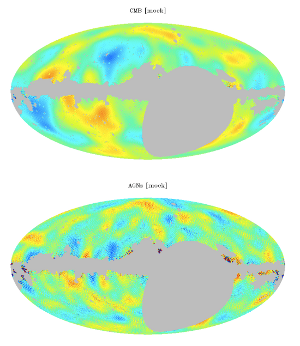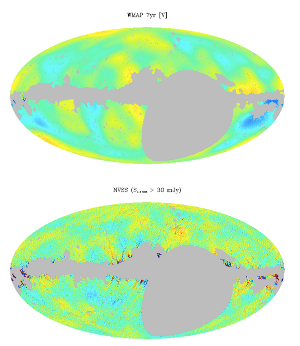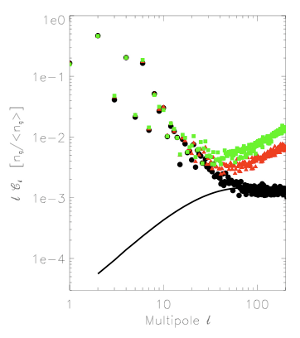|
|  |
Radio-loud AGNs are galaxies that host a super-massive black hole in
their centre that is accreting material from its surroundings. These
AGNs have been found to very large distances, corresponding to times
when our universe was less than half its current age. Other
observations indicate that around this time, the universe becomes
dominated by a new component different from matter and radiation,
called "Dark Energy", which counteracts the attractive forces of
gravity and hence accelerates the expansion rate of the Universe.
This Dark Energy is subject of intensive research. Major on-going and
upcoming optical surveys attempt to characterize its nature by
investigating how it modifies the lensing pattern of galaxies or their
clustering, or by directly measuring the expansion rate at different
cosmological epochs. One clear cut prediction for Dark Energy is that
it should modify the growth of gravitational potential wells on the
largest scales, if it indeed accelerates the expansion rate of the
universe. In a Universe with a flat geometry such as ours, in the
absence of Dark Energy gravitational potential wells should remain
constant: their growth due to gravitational enhancement of
overdensities is perfectly cancelled by the expansion rate of
space. However, if Dark Energy becomes dominant and accelerates the
universal expansion rate, then these gravitational potential wells
should become shallower, at least on the largest scales.
This shrinking of the potential wells should have an observable effect
on the intensity anisotropies of the Cosmic Microwave Background
(CMB). This radiation was emitted at very early epochs of our
universe, roughly 380,000 years after the Big Bang, and has crossed
the whole visible universe when it reaches us. In particular, the CMB
photons must have crossed the evolving gravitational potential
wells. If these have become shallower during the time required for CMB
photons to cross those wells, then these photons should have gained
some energy, since they leave a potential well that is shallower at
exit than it was at entrance. This gravitational "blue-shift" of the
CMB is known as the Integrated Sachs-Wolfe effect (hereafter ISW).
The number of gravitational potential wells varies along different
directions on the sky, which means that the ISW effect will introduce
angular anisotropies on the intensity pattern of the CMB. Now, if
galaxies and AGNs preferentially form in those same potential wells,
then there should be some correlation between the angular pattern of
the CMB and the AGN angular distribution. Figure 1 shows this
similarity in two simulated maps of the CMB radiation and the angular
density fluctuations of radio galaxies after filtering out small scale
anisotropies. On large angular scales (corresponding to large
gravitational potential wells) both maps show some resemblance, which
can be measured with high significance by applying a statistical
analysis.
Applying the same statistics to real observational data, however,
shows no significant similarity between these two maps. Figure 2 shows
real CMB data (as measured by the WMAP satellite) and the angular
distribution of objects in the NRAO VLA Sky Survey (NVSS) catalogue,
which contains some 1.6 million extragalactic radio sources, of which
more than 99% should be AGNs.
What does this mismatch mean? The CMB, on the one hand, has been
compared to theoretical expectations and has proved to be in good
agreement overall. On the other hand, the fluctuations of NVSS sources
on large scales show a clear excess when compared to predictions. The
fact that this excess is present for different flux thresholds
(i.e. also brightest, clearly detected sources, show this abnormal
behaviour) makes any observational systematic unlikely - but not
impossible.
Is this excess of large scale anisotropy of radio AGN comparable to
that recently claimed in the Sloan catalogue of Luminous Red Galaxies?
Is this excess a signature of intrinsic non-Gaussianity in the matter
fluctuation field in our universe? Do the AGNs in NVSS really sample
the large scale gravitational wells? Can we derive conclusions on the
mysterious Dark Energy from this result? These are all exciting, open
questions, which are the subject of current investigations.
Carlos Hernandez-Monteagudo
Further information:
Carlos Hernandez-Monteagudo,
"Revisiting the WMAP-NVSS angular cross correlation. A skeptic's view",
Astronomy & Astrophysics, 520, 101 (2010),
 arxiv:0909.4294 arxiv:0909.4294
|


